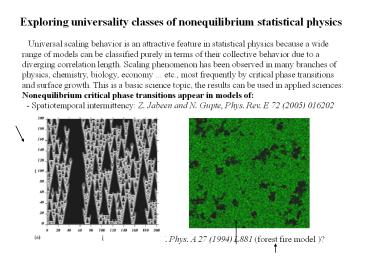Exploring universality classes of nonequilibrium statistical physics - PowerPoint PPT Presentation
1 / 14
Title:
Exploring universality classes of nonequilibrium statistical physics
Description:
Exploring universality classes of nonequilibrium statistical ... Prototype: sandpile model ... Bak-Tang-Wiesenfeld sandpile model. Scaling in biological system ... – PowerPoint PPT presentation
Number of Views:47
Avg rating:3.0/5.0
Title: Exploring universality classes of nonequilibrium statistical physics
1
Exploring universality classes of nonequilibrium
statistical physics Universal scaling
behavior is an attractive feature in statistical
physics because a wide range of models can be
classified purely in terms of their collective
behavior due to a diverging correlation length.
Scaling phenomenon has been observed in many
branches of physics, chemistry, biology, economy
... etc., most frequently by critical phase
transitions and surface growth. This is a basic
science topic, the results can be used in applied
sciencesNonequilibrium critical phase
transitions appear in models of -
Spatiotemporal intermittency Z. Jabeen and N.
Gupte, Phys. Rev. E 72 (2005) 016202
- Population dynamics E. V.
Albano, J. Phys. A 27 (1994) L881 (forest fire
model )?
2
Nonequilibrium critical phase transitions appear
in models of - Epidemics spreading
T. Ligget, Interacting particle systems
1985 - Catalysis Da-yin Hua,
Phys. Rev E 70 (2004) 066101, - Itinerant
electron systems D. E. Feldman, Phys. Rev. Lett
95 (2005) 177201, - Cooperative transport
S. Havlin and D. ben-Avraham, Adv. Phys. 36
(1987) 695,
3
(No Transcript)
4
(No Transcript)
5
(No Transcript)
6
Scaling in biological system
- Life-span tends to lengthen--and metabolism slows
down--in proportion to the quarter power of an
animal's body weight. - Explanations based on scaling arguments
- In animals and plants, circulatory systems
resemble branching fractal networks, and
capillary size does not depend on organism size.
G.West et al. Science (4 April 1997, p.122)? - Optimal nuitrient distribution networkNature '99
Banavar et al. Similar to river network models - Multiscaling
7
(No Transcript)
8
(No Transcript)
9
For more details see the new book
- Universality in nonequilibrium lattice systems,
Theoretical foundations, World Scientific,
Singapore, 1-295 oldal (2008). http//www.worldsci
books.com/physics/6813.html
10
Phase transition to absorbing state in branching
and annihilating random walk (BARWn) models
- A ? (1n) A, 2A ? 0
- For n 1 (n odd) below dc A ???reaction is
generated due to fluctuationsdirected
percolation (DP) universalitycontact process,
epidemic spreading - For n 2 (n even) the A ?????reaction is not
generated, parity conserving (PC) universality
class
lt----------gt
11
Space-time evolution of universal, nonequilibrium
reaction-diffusion models with zero density
absorbing states
- Unary particle production spreading without and
with parity conservation A ? (1m)A, 2A ? 0 - Binary particle production spreading coupled to
slave modes without and with diffusion 2A ?
(2m)A, 2A ? 0Drifting scaling exponents by
varying the diffusion rate G.Ódor, Phys. Rev. E
62 (2000) R3027. or two classes ?
12
The challenging binary production, diffusive pair
contact process (PCPD)?
- Two zero particle density absorbing (odered)
states without symmetry, (Carlon et al. PRE
2001). Numerical methods show new exponents, but
results are controversial. No extra symmetries or
conservation laws found to explain them - Bosonic field theories (allowing multiple site
occupancy) have failed to describe the critical
behavior. In the bosonic model variant in the
active phase the particle density diverges. - Fermionic model show different critical behavior,
but perturbative field theoretical
renormalization did not find stable fixed point
corresponding to the novel scaling behavior
(2004). For a review seeM. Henkel and H.
Hinrichsen, J. Phys. A37, R117-R159 (2004)?
13
Challening problems
- Understanding the role symmetries and
conservation laws in such system - In 1d two classes, non-universal or DP scaling ?
Numerical confirmation following density decay is
needed. - Proper correction-to scaling analysis to density
decay r At-a Bt-a-x ..
a ?, x ? - More complex nA ? (nm) A type reaction
-diffusion models with n gt 2 show similar new
universal behavior in low dimensions ...
14
Parallel algorithm realizations
- Master-worker setup, Single Program Multiple Data
(SPMD) algorithm. - The slave processes are completely identical and
sequential. Minimal communication losses, easy
program development































